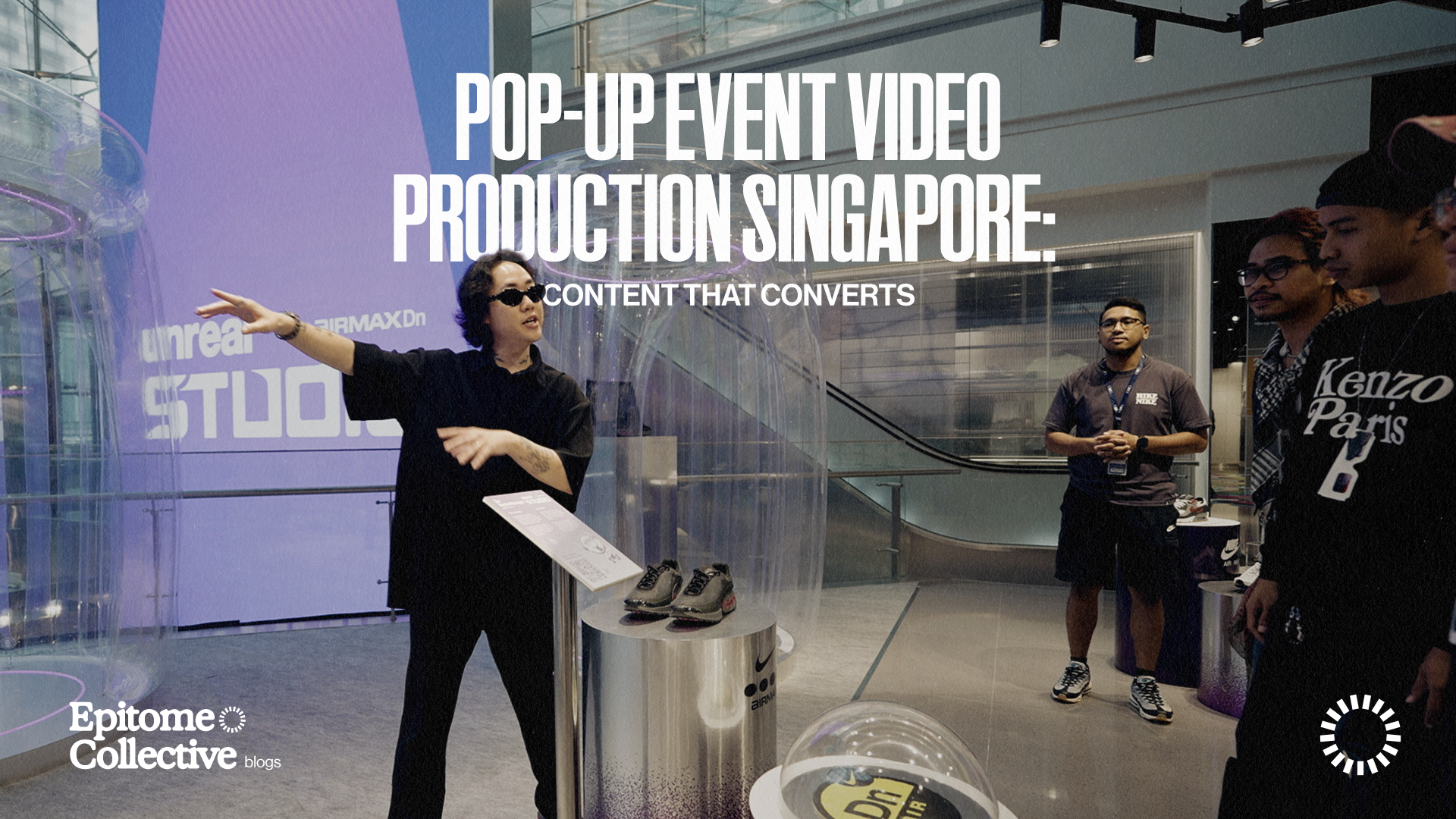Singapore Video Production 101: Process, Pricing, and Project Success
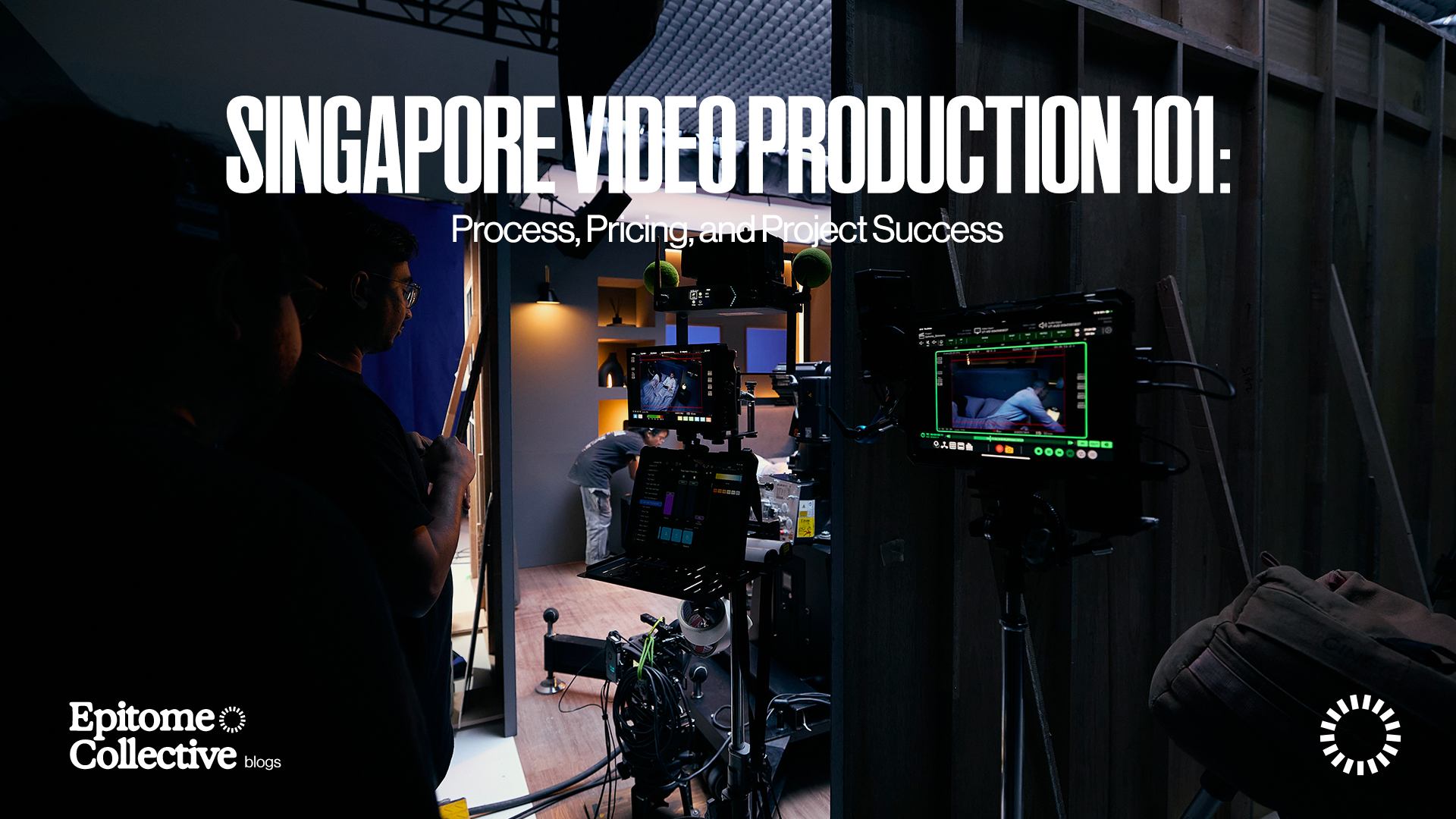
Singapore Video Production 101: Process, Pricing, and Project Success
If you’re considering a video project, your first question is probably:
How much does a good video cost?
Closely followed by:
What am I actually paying for?
You’re not alone. Whether it’s your first time managing a video or you’ve done it before and want to improve, the process can feel confusing. What steps are involved? How do you plan properly? And how can you avoid wasting time or money?
That’s exactly what this guide is here to help with.
In today’s world, video is everywhere. It’s how brands connect, how founders share their story, and how businesses cut through the noise. But while videos are common, producing one that truly works in Singapore is less straightforward than it seems.
This guide walks you through the entire video production process in Singapore. You’ll learn what happens at each stage, from planning to post-production. We’ll also cover timelines, costs, and popular formats, so you can plan smarter and get better results from your next project.
What Is Video Production?
Video production isn’t just about picking up a camera and filming something. It’s about creating a visual asset with a clear purpose, whether that's to inform, persuade, build your brand, or drive action.
In Singapore’s fast-moving media landscape, where formats are constantly evolving, success means balancing creative ideas with technical precision.
The Three Core Phases of Video Production
Every video project, no matter the format or platform, goes through three key stages:
- Pre-Production: Planning and preparation
- Production: The actual shoot
- Post-Production: Editing and finishing
Each phase builds on the one before it. When done well, the process runs smoothly from start to finish. But if corners are cut early, problems show up later.
Let’s take a closer look at each phase.
Pre-Production: Setting the Direction
Pre-production lays the foundation for a successful project. This is where the creative vision is established, messaging is refined, and logistical planning takes place.
At this stage, typical activities include:
- Defining the overall concept and visual style
- Outlining key messages and audience objectives
- Developing scripts and storyboards
- Planning shoot logistics, including locations, timelines, and budgets
Strong pre-production ensures the production phase runs efficiently. When the direction is clear from the start, the entire process stays aligned and focused.
Production: Capturing the Vision
Production is the execution phase where creative ideas are brought to life on camera. This is where all planning transitions into on-the-ground action.
Key activities often involve:
- Capturing scripted scenes on location or in studio
- Coordinating talent, crew, and equipment
- Managing lighting, camera setups, and sound
- Maintaining consistency with the original vision
Precision and coordination are essential during this phase, especially in time-sensitive environments where shoot schedules are tightly managed.
Post-Production: Crafting the Final Story
Post-production is where the raw material becomes a finished piece. It’s the stage where structure, tone, and emotion are refined to create a cohesive and engaging story.
This phase typically involves:
- Editing footage into a structured narrative
- Enhancing visuals through colour grading and effects
- Designing sound and integrating music
- Final reviews and quality control
Post-production is often the most creatively transformative part of the process. It brings all the elements together into a polished, audience-ready final product.
Why Each Phase Matters
Each stage affects the next:
- Poor planning slows down the shoot.
- Weak footage limits the edit.
- Rushed post-production weakens the final product.
When all three phases are aligned, the end result feels seamless and delivers impact.
Popular Video Formats in Singapore
Singapore’s diverse business landscape means video formats vary widely. These are the most common types:
Corporate Videos
These include internal training, onboarding, explainer content, and company updates. Many companies now aim to make corporate videos more human and visually interesting.
Branded Content and Commercials
These are designed to perform. Think brand films, product showcases, or TV commercials. They mix storytelling with strategy and often require larger crews, more detailed planning, and higher-end production.
Social Media Videos
These are short, platform-specific clips for reels, stories, or paid ads. They need to hook viewers quickly and be mobile-friendly. While some are cut from longer shoots, more brands are now producing them as stand-alone content.
Event Coverage
Event coverage requires both speed and strategy, whether it's a corporate event, brand activation, music festival, roadshow or keynote conference. Each setting comes with its own challenges. This can range from capturing clear, polished moments at formal gatherings to keeping up with the energy and movement of live crowds. Success depends on fast, accurate filming, a flexible crew and the ability to turn live experiences into engaging content that keeps the moment alive long after the event ends.
Animations and Motion Graphics
Whether it’s a fully animated explainer or dynamic motion overlays on live-action content, animation and motion graphics bring abstract ideas to life. They’re especially effective for product demos, infographics, UI walkthroughs, or storytelling where live action can’t go. Motion design can also elevate edits in other formats, giving corporate videos, social content, and branded films an extra layer of polish and personality.
Choosing the Right Format
In Singapore, audiences move fast but expect high quality.
Start by choosing the format that best fits your message. Then, make sure your production process is built to support that goal from the very beginning.
Pre-Production in Singapore: Where Successful Projects Begin

Before the cameras roll or the editing begins, every great video starts with one crucial step: pre-production.
This is the planning phase. It may not be glamorous, but it shapes everything that comes after. Think of it like building a house. Without a solid foundation and clear blueprint, the final result can easily go off track.
Not sure how to begin? That’s where a good production partner makes a difference. They will guide and manage every step, starting with the creative brief.
1. The Video Production Brief: Defining the Vision
A clear brief sets the direction for your entire project. It aligns everyone on the goals and creative intent.
A strong brief should cover:
- The goal of the video (brand awareness, internal communication, lead generation?)
- Who it's for (target audience)
- Key messages and takeaways
- Tone and visual style
- Platform or format (YouTube, LinkedIn, internal training?)
- Project timeline and milestones
- Budget range
- Any essentials (e.g. subtitles, specific talent, brand guidelines)
Unsure about what to include? A production partner like Epitome can help shape your brief during a discovery session.
2. Creative Development: Bringing the Idea to Life
Once you’ve got a brief, the creative development stage begins. This is where your objectives become a visual concept.
This phase may include:
- A script or structured talking points
- Moodboards and visual references
- A treatment deck (a short document outlining the style, tone, and structure)
- Refinement of key messages
The aim is to clarify the story, tone, and emotion of your video, setting a clear path for production and editing.
3. Scoping and Budgeting: Planning for Success
Once the concept is defined, it’s time to scope out the production.
Considerations include:
- Shoot days: One well-organised day is often better than multiple inefficient ones
- Locations: Studios offer control; public areas may need permits and crowd management
- Talent: Hiring professionals costs more than using internal staff or real customers
- Crew size: Depends on the complexity – from a compact team to full camera, lighting, and styling
- Extras: Drones, animation, licensed music, or special effects can raise post-production costs
Smart budgeting isn’t about spending more – it’s about making the most of your resources.
4. Locations, Casting, and Crew Logistics

With the scope clear, it’s time to nail down the details.
Locations
Singapore has strict filming regulations. You may need permits from URA, LTA, or private property owners. Some approvals can take weeks.
Casting
Depending on your story, you may need actors, presenters, or real people. Costs depend on screen time, experience, and how the footage will be used.
Crew
The crew should match your creative needs and budget. A lean team might suit talking-head interviews; bigger productions may require more sophisticated equipment, such as full scale sets, robotic camera arms and specialized cranes.
5. Mistakes to Avoid in Pre-Production
Some common pitfalls can delay or derail your project:
- Lack of clarity: No clear concept or script can lead to confusion on set
- Team misalignment: If everyone isn’t on the same page, revisions and delays are inevitable
- Late decisions: Last-minute changes create stress and extra costs
- Ignoring logistics: Permit lead times, bookings, and scheduling matter
- Trying to do too much: Packing too much into one shoot day can compromise quality
Why Pre-Production Matters
Great videos look effortless. But behind every smooth production is careful planning.
Pre-production is where the vision is defined, the logistics are locked in, and the creative foundation is laid. Done well, it saves time, money, and stress and sets the whole project up for success.
If you're not sure where to begin, you don’t have to do it alone. A trusted partner can help you navigate every step, from creative brief to shoot day and beyond.
Production Phase: What Happens on Set in Singapore
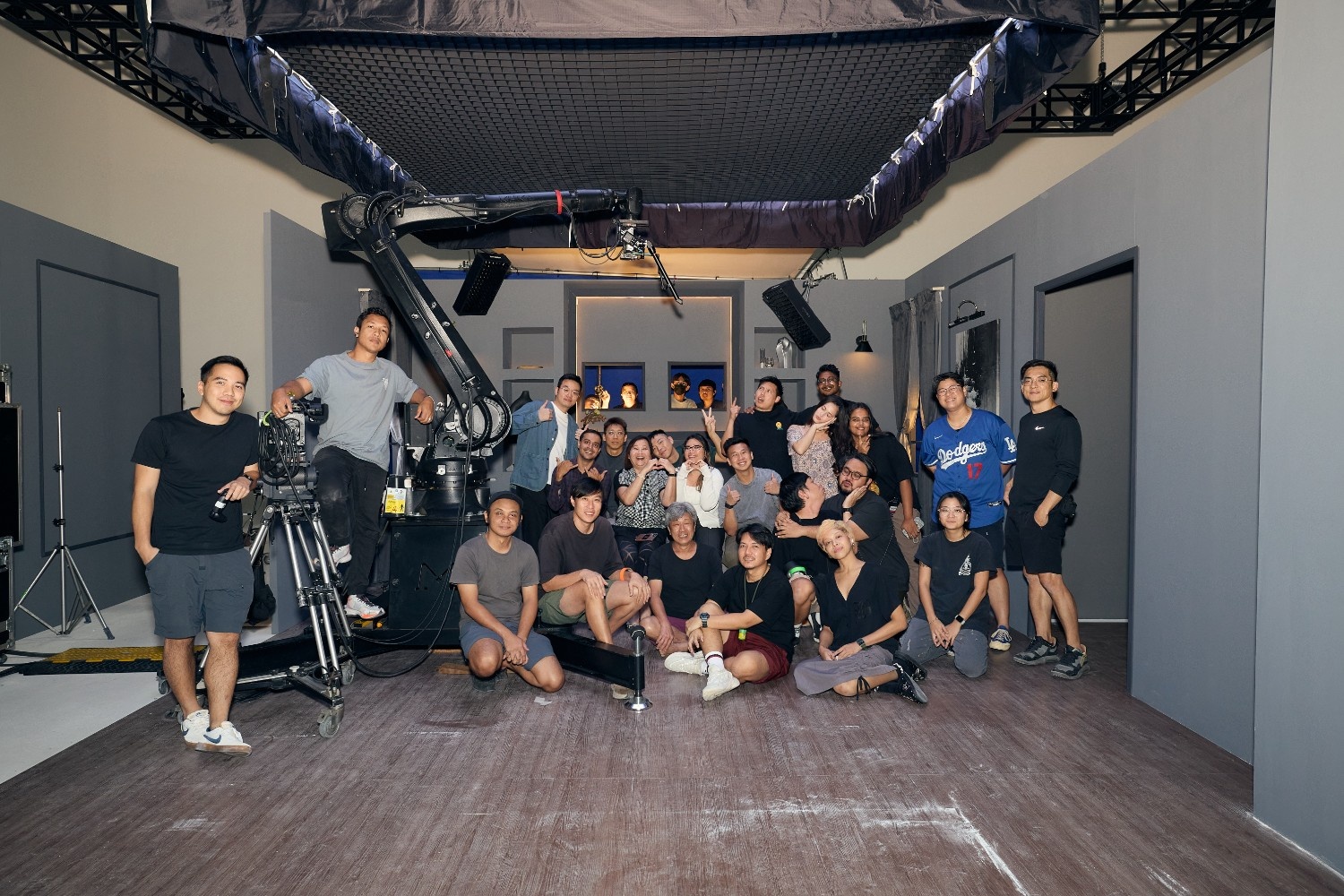
If pre-production is where plans are drawn up, then production is when everything gets built quickly, live, and with no room for error.
This is the shoot itself. It’s typically the shortest phase of the project, but it demands the most coordination. A single day of filming can take weeks of planning. Without clear logistics, even a simple shoot can result in delays, reshoots, or missed opportunities.
That’s why experienced production teams treat this phase like a live operation. Every shot, setup, and role is planned in detail so the day runs efficiently and delivers the intended results.
How a Shoot Day Is Structured
Each shoot is organised using a callsheet, shared in advance with all crew and talent. It includes:
- Arrival times for crew and talent
- Scene and shot breakdown
- Gear and lighting requirements
- Location access details
- Emergency contacts and client representatives
On set, the production team manages the full timeline, from setup and lighting checks to filming, reviews, and wrap. The producer ensures things stay on schedule, while the director focuses on bringing the creative vision to life.
Who’s Involved and Why It Matters
Even small-scale productions rely on a coordinated team. A typical shoot crew might include:
- Director – responsible for creative execution
- Producer – manages logistics and client communication
- Director of Photography (DOP) – oversees the camera and visual style
- Camera Assistant – supports focus, rigging, and equipment setup
- Gaffer – handles lighting setup and adjustments
- Sound Recordist – ensures clean, high-quality audio
- Hair and Makeup Artist – prepares on-camera talent
Each role is designed to reduce issues and improve quality. The better the coordination, the smoother the execution and the stronger the footage.
Filming Locations in Singapore
Most shoots fall into one of two setups:
- Studio Shoots: Offer full control over lighting and sound. Ideal for interviews, green screen shoots, or product demos.
- On-Location Shoots: Offices, public spaces, or retail environments. These provide realism but also require extra planning for things like noise, power supply, and permits.
In Singapore, public and commercial locations usually require permits from URA, LTA, Nparks, or venue operators. Your production partner should manage these approvals in advance, along with any site logistics.
Equipment and Technical Setup

Every equipment decision supports the creative intent.
- Handheld cameras create energy and movement
- Long lenses change how space is perceived
- Drones provide scale and cinematic perspective
It’s not about using the most expensive gear, it’s about using the right gear for the project. Your production team will spec out a kit that fits both the look you want and the platforms the video will appear on.
Your Role as the Client
To keep things efficient on set, assign one main contact who can:
- Review takes or approve key visuals
- Sign off on framing, dialogue, or styling
- Coordinate internal feedback if other stakeholders are present
When clients are focused and aligned with the production team, everything runs more smoothly and the end result is stronger.
What a Great Shoot Day Looks Like
A successful production day is calm, well-organised, and productive. There’s no chaos or second-guessing. Just a team working with clarity, focus, and a shared understanding of the goal.
Post-Production in Singapore: Editing, Colour, and Final Touches
If pre-production is the plan and production is the shoot, then post-production is where everything comes together. It’s the stage where raw footage is shaped into a final video that feels polished, purposeful, and ready to publish.
Post-production is more than editing clips together. It’s about making creative and technical choices that sharpen the message, elevate the visuals, and ensure the content works across its intended platforms.
What Post-Production Really Involves
For many clients, this is the least visible part of the process but it’s where much of the real work happens.
Here’s what a typical post-production workflow looks like:
1. Footage Ingestion and Backups
All filmed content is backed up and organised. Footage is renamed and sorted by scene, take, and format. This basic step is essential for a smooth, efficient edit and ensures nothing gets lost.
2. Rough Cut Assembly
Editors start by building a rough version of the video using the best takes. At this stage, visuals aren’t polished, the goal is to check the structure, flow, and message. This version is shared for early feedback before moving into detailed refinement.
3. Fine Cut and Feedback Cycles
The edit is tightened with careful adjustments to pacing, transitions, audio, and visuals. Feedback is gathered using time-stamped tools like Frame.io to make collaboration clear and efficient. Revisions are structured into rounds to keep progress on track.
4. Graphics, Titles, and On-Screen Elements
Motion graphics, lower thirds, product callouts, and text overlays are added. These design elements are built for clarity, brand alignment, and the platform the video is targeting, whether that’s a website, social feed, or internal channel.
5. Sound Design and Music Licensing
Audio is cleaned up, mixed, and enhanced. This includes dialogue levelling, background ambience, sound effects, and music. If licensed music is used, your production partner should handle clearance, usage rights, and tone matching.
6. Colour Grading
This is the final visual pass. Colour grading corrects contrast, lighting, and saturation to ensure consistency across scenes. It also sets the mood and gives the video a finished, professional look.
7. Mastering and Export
The final video is exported in all necessary formats, such as:
- Full-resolution master files
- Platform-specific versions (e.g. 16:9 for YouTube, 9:16 for Instagram Reels)
- Versions with subtitles or captions
- Compressed files for web or mobile use
Everything is archived and structured so it’s easy to update or reuse in the future.
What Affects Post-Production Timelines
Turnaround times depend on complexity. Key factors include:
- Footage volume: More footage takes longer to sort and review
- Number of deliverables: More versions mean more editing time
- Graphics or animation: These take additional design and revision cycles
- Feedback cycles: Delays or scattered comments can slow down progress
Here’s a general guide:

Timelines are typically discussed early on and adjusted if needed based on priorities.
Keeping the Feedback Process Efficient
To avoid delays, clients should:
- Assign one main point of contact for approvals
- Consolidate feedback into each revision round
- Be clear on what’s a business priority versus personal preference
- Respond promptly to keep momentum going
Your production partner will handle the version control, apply edits, and ensure everything is delivered on time and on spec.
Why Post-Production Matters
Post-production is where everything finally clicks. It’s not just editing it’s storytelling, design, and strategy all working together.
A well-finished video isn’t just nice to look at. It performs better, communicates more clearly, and leaves a stronger impression.
How Much Does Video Production Cost in Singapore?
Video production costs in Singapore can vary widely. Rather than looking for a flat rate, it’s more useful to understand what affects the price. Once you know the key cost drivers, you’ll be able to evaluate quotes with more confidence and plan your budget more effectively.
What Really Drives the Cost?
Several factors have a direct impact on the total budget. These are the main elements that determine whether a project is lean and efficient or higher-end and complex:
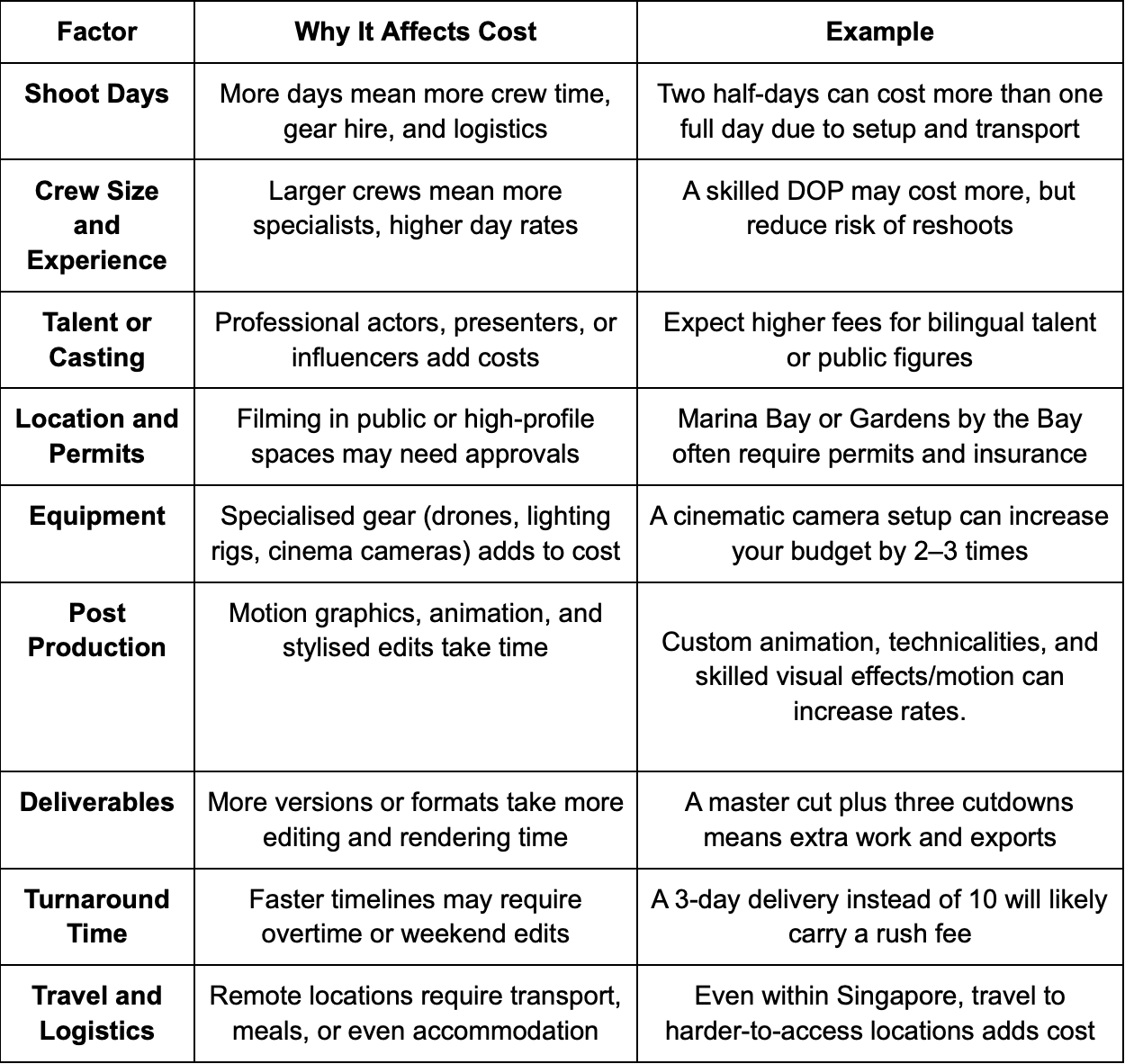
Example Budget Ranges (For Reference Only)
While actual costs depend on your specific project, here are some ballpark ranges to help set expectations:
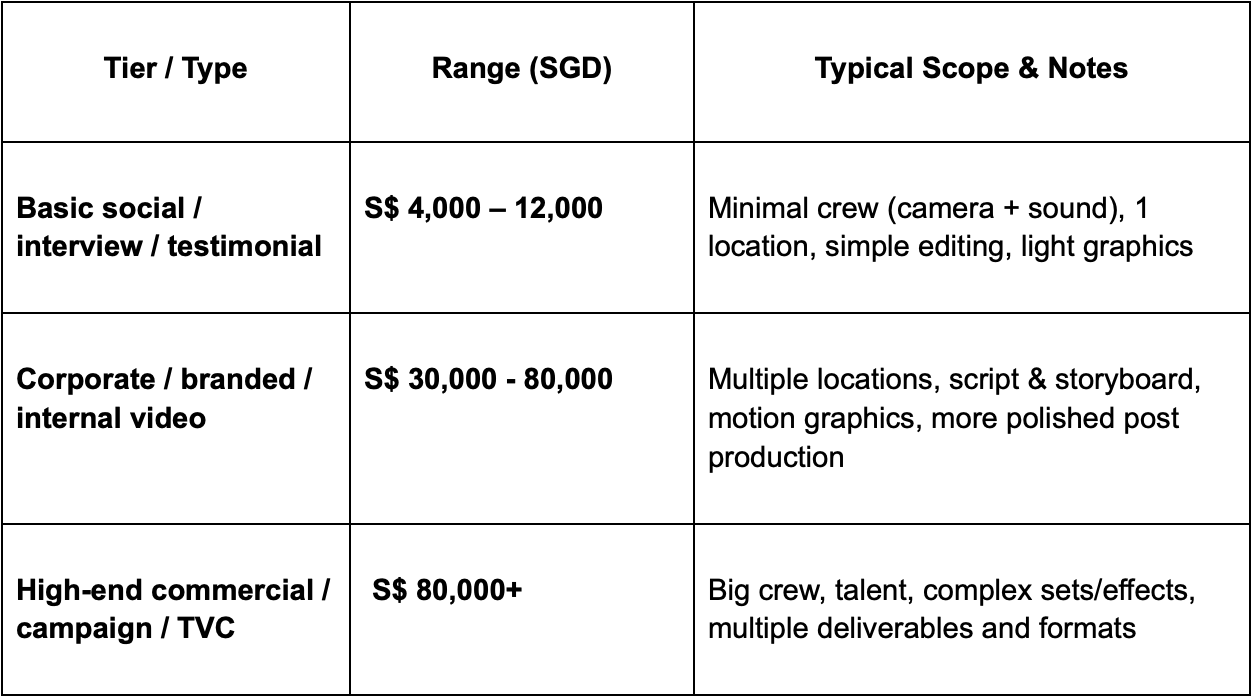
These are not fixed prices, they simply help you compare what’s typical for different levels of production.
How to Use This When Planning a Video
To make the most of your budget:
- Ask for a detailed breakdown: Understand what portion of the quote is going to crew, gear, post-production, or licensing.
- Know your ceiling: Set your internal max budget early, even if you don’t reveal it right away.
- Trim wisely: If you need to reduce costs, scale back on deliverables, visual complexity, or locations not the core creative idea.
- Leverage scale: Bundling multiple videos into one shoot can help spread fixed costs across assets.
- Be realistic about timelines: Fast turnarounds cost more. If budget is a concern, allow more time for production and post.
What Makes a Video Production Project Truly Successful?

If you’re managing a video project for the first time, it can feel overwhelming, especially when quotes vary, timelines seem unclear, and deliverables aren't well defined.
This section explains what a good production partner should actually provide, and how you can keep your project on track from start to finish. Whether you're a marketer, brand owner, or creative lead, these insights will help you scope better, stay aligned, and avoid hidden costs.
1. Discovery and Creative Alignment: Ask the Right Questions
Many projects fall off course because they skip this first step: proper alignment.
A good production partner won’t just ask for your budget. They’ll start with strategic questions:
- What’s the goal of the video? (Brand awareness, lead generation, training, etc.)
- Who is the audience? What do they need to understand or feel?
- Where will it live? (Out of home, LinkedIn, YouTube, internal platform, sales deck)
- What tone and style are you aiming for? (Polished, casual, emotive, bold)
- What constraints exist? (Timelines, legal approvals, fixed launch dates)
This early alignment turns vague ideas into clear direction, and helps the team deliver creative that works, not just creative that looks good.
2. Concept Development: Ideas You Can Actually Execute
Once the brief is locked, concept development begins. Depending on your project, this could include:
- Creative concept decks to explore multiple directions
- Treatment documents that show how the video will look and feel
- Scripts or interview guides built around messaging goals
- Storyboards or shot lists to visualise scenes in advance
The best ideas are the ones that fit your timeline and budget. A good production partner will only pitch concepts that are realistic for your scope not just aspirational on paper.
3. Scoping: Transparency Over Guesswork
You should never receive a single-line quote with no breakdown.
A well-scoped proposal includes:
- Pre-production: Creative development, casting, locations, scripting
- Production: Shoot days, crew roles, equipment, locations, talent
- Post-production: Editing, colour, sound design, graphics
- Deliverables: Cutdowns, social formats, captions, thumbnails
- Licensing: Music, voiceover, or third-party assets (if needed)
A clear breakdown helps you see where your budget is going and what you can scale up or down as needed.
4. Planning and Coordination: One Point of Contact
Behind every smooth shoot is a well-run logistics plan.
Your production partner should handle:
- Booking crew, talent, and locations
- Securing permits and approvals
- Renting gear and scheduling setup times
- Preparing callsheets and day plans
- Managing risk (backup gear, weather contingencies, insurance)
You shouldn’t be chasing updates or tracking five people. A single producer should coordinate the entire project and act as your point of contact.
5. Execution and Feedback: Clear Process, No Surprises
During production and post, communication should stay tight and structured. Expect:
- A shoot-day schedule and checklist of what needs to be approved
- A feedback workflow using version tracking and time-stamped comments
- A clear timeline that shows what’s expected from your side (e.g. review deadlines)
If these systems aren’t in place, things can quickly spiral and delays, costs, or confusion follow.
6. Delivery and Reuse: Think Beyond One Video
A finished video should come with everything you need to get value from it long-term:
- Full-resolution master files
- Platform-ready exports (e.g. landscape, portrait, square)
- Subtitles and SRT files
- Archive-friendly formats for easy reuse
- Thumbnails and visual assets for publishing
Smart production planning means you can reuse your content across campaigns, platforms, and timeframes.
Red Flags to Watch Out For
If you’re comparing vendors, these are signs that a production partner may not be up to standard:
- No discovery or strategy phase
- Vague quotes with no breakdown of costs
- No clear revision or feedback workflow
- No alignment meetings
- No licensing documentation for music, voiceover, or stock
- No plan for managing timelines or handling revisions
These gaps often lead to extra costs or underwhelming results.
Working with a production partner isn’t just about handing over a brief. It’s about creating clarity and confidence from concept to delivery.
Ready to Get Started? Epitome Collective Can Help

If you're planning a video project and want to ensure it's done right, from strategy to shoot to final delivery, Epitome Collective is here to support you at every stage of the process.
We’re not just making videos. We’re crafting visual work that hits with purpose and clarity. Whether you're after a high-impact brand film, a scroll-stopping social ad, or sleek motion graphics, we align every creative decision with your brand values and business goals.

